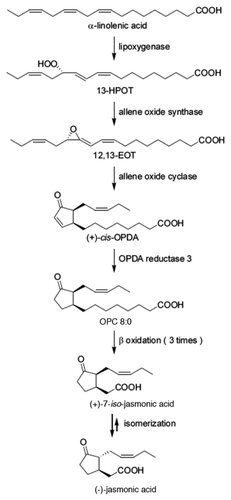Figures & data
Figure 2. Evaluation of (+)-cis-OPDA, JA-Ile, and JA in G. fujikuroi. The fungus was treated with airborne MeJA-d5. The endogenous amounts of (+)-cis-OPDA, JA-Ile and JA were analyzed by UPLC-MS/MS with MRM in negative mode. (a) The presence of (+)-cis-OPDA. Upper panel: The peak derived from [17,17,18,18,18-2H5] (+)-cis-OPDA (internal standard) was monitored by selecting m/z 296.37 as the pseudomolecular ion and m/z 170.99 as the transition ion. Lower panel: The peak derived from (+)-cis-OPDA (endogenous compound) was monitored by selecting m/z 291.37 as the pseudomolecular ion and m/z 164.99 as the transition ion; (b) The evaluation of endogenous amounts of (+)-cis-OPDA; (c) The evaluation of endogenous amounts of JA-Ile; (d) The evaluation of endogenous amounts of JA; (e) The presence of [2,2,5,5,7-2H5] JA derived from deuterium-labeled MeJA. Upper panel: The peak derived from [2,2,5,5,7-2H5] JA was monitored by selecting m/z 214.00 as the pseudomolecular ion and m/z 60.71 as the transition ion. Lower panel: The peak derived from JA (endogenous compound) was monitored by selecting m/z 209.00 as the pseudomolecular ion and m/z 58.71 as the transition ion. Each value is represented by the mean ± SD of five independent replicates. Welch’s test, **p< 0.01, *p< 0.05. x) originated from the acetone extract (100 mL).
![Figure 2. Evaluation of (+)-cis-OPDA, JA-Ile, and JA in G. fujikuroi. The fungus was treated with airborne MeJA-d5. The endogenous amounts of (+)-cis-OPDA, JA-Ile and JA were analyzed by UPLC-MS/MS with MRM in negative mode. (a) The presence of (+)-cis-OPDA. Upper panel: The peak derived from [17,17,18,18,18-2H5] (+)-cis-OPDA (internal standard) was monitored by selecting m/z 296.37 as the pseudomolecular ion and m/z 170.99 as the transition ion. Lower panel: The peak derived from (+)-cis-OPDA (endogenous compound) was monitored by selecting m/z 291.37 as the pseudomolecular ion and m/z 164.99 as the transition ion; (b) The evaluation of endogenous amounts of (+)-cis-OPDA; (c) The evaluation of endogenous amounts of JA-Ile; (d) The evaluation of endogenous amounts of JA; (e) The presence of [2,2,5,5,7-2H5] JA derived from deuterium-labeled MeJA. Upper panel: The peak derived from [2,2,5,5,7-2H5] JA was monitored by selecting m/z 214.00 as the pseudomolecular ion and m/z 60.71 as the transition ion. Lower panel: The peak derived from JA (endogenous compound) was monitored by selecting m/z 209.00 as the pseudomolecular ion and m/z 58.71 as the transition ion. Each value is represented by the mean ± SD of five independent replicates. Welch’s test, **p< 0.01, *p< 0.05. x) originated from the acetone extract (100 mL).](/cms/asset/ce260bc9-f1d4-459a-9913-41c5cda7a88f/tbbb_a_1617108_f0002_b.gif)
Figure 3. Evaluation of JA in F. commune. The fungus was treated with airborne MeJA-d5. The endogenous amounts of JA were analyzed by UPLC-MS/MS with MRM in negative mode. (a) The evaluation of endogenous amounts of JA; (b) The presence of [2,2,5,5,7-2H5] JA derived from deuterium-labeled MeJA. Upper panel: The peak derived from [2,2,5,5,7-2H5] JA was monitored by selecting m/z 214.00 as the pseudomolecular ion and m/z 60.71 as the transition ion. Lower panel: The peak derived from JA (endogenous compound) was monitored by selecting m/z 209.00 as the pseudomolecular ion and m/z 58.71 as the transition ion. Each value is represented by the mean ± SD of five independent replicates. Welch’s test, **p< 0.01, *p < 0.05. x) originated from the acetone extract (100 mL).
![Figure 3. Evaluation of JA in F. commune. The fungus was treated with airborne MeJA-d5. The endogenous amounts of JA were analyzed by UPLC-MS/MS with MRM in negative mode. (a) The evaluation of endogenous amounts of JA; (b) The presence of [2,2,5,5,7-2H5] JA derived from deuterium-labeled MeJA. Upper panel: The peak derived from [2,2,5,5,7-2H5] JA was monitored by selecting m/z 214.00 as the pseudomolecular ion and m/z 60.71 as the transition ion. Lower panel: The peak derived from JA (endogenous compound) was monitored by selecting m/z 209.00 as the pseudomolecular ion and m/z 58.71 as the transition ion. Each value is represented by the mean ± SD of five independent replicates. Welch’s test, **p< 0.01, *p < 0.05. x) originated from the acetone extract (100 mL).](/cms/asset/a544528f-1c9b-4a39-8f10-80fb936beaf7/tbbb_a_1617108_f0003_b.gif)

